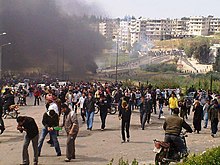This is an old revision of this page, as edited by AnomieBOT (talk | contribs) at 03:21, 18 December 2024 (Substing templates: {{Realist}}. See User:AnomieBOT/docs/TemplateSubster for info.). The present address (URL) is a permanent link to this revision, which may differ significantly from the current revision.
Revision as of 03:21, 18 December 2024 by AnomieBOT (talk | contribs) (Substing templates: {{Realist}}. See User:AnomieBOT/docs/TemplateSubster for info.)(diff) ← Previous revision | Latest revision (diff) | Newer revision → (diff)
.
The term Cradle of the Revolution refers to a historically significant location (typically a city or town or an area within one) where a political revolution began. Such cities often bear outsized importance in the national and/or historical narrative of a country, and may be home to a number of national museums and monuments.
The term derives from infant cradles, referring to a revolution being gradually "nursed" from a young age (e.g. small uprising) until it becomes mature (e.g. full-scale revolt and/or civil war).
Examples
- Bastille, Paris, France - Cradle of the French Revolution (see Storming of the Bastille)
- Boston, Massachusetts and Philadelphia, Pennsylvania - Cradles of the American Revolution (see Faneuil Hall, AKA the "Cradle of Liberty")
- Daraa, Syria - Cradle of the Syrian revolution
- Petrograd, Russian Empire - Cradle of the Russian Revolution
- Sidi Bouzid, Tunisia - Cradle of the Tunisian revolution
- Timișoara, Romania - Cradle of the Romanian revolution
References
- https://www.arabnews.com/node/1291041/middle-east
- https://www.france24.com/en/20151217-focus-tunisia-revolution-bouazizi-sidi-bouzid-revolution-poverty-unemployment-frustration
- https://www.france24.com/en/europe/20191129-romania-timisoara-economic-hub-and-cradle-1989-revolution-former-communist-state-european-capital-culture